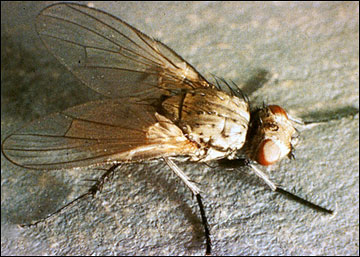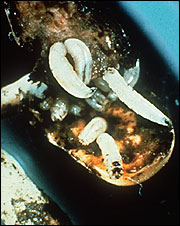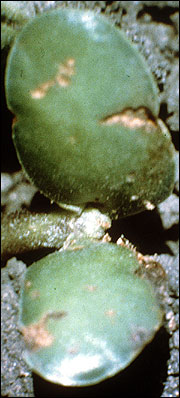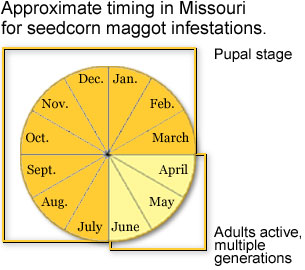The seedcorn maggot, Delia platura (Meigen), is an occasional pest of agronomic crops in Missouri. This insect is widely distributed throughout the temperature zones of the world. It was discovered in the United States in 1855. This insect feeds on the seeds and roots of many different grain (e.g., corn, soybeans) and vegetable (peas, watermelons) crops.
Description and life cycle
This insect typically overwinters in the larval stage inside a puparium (dark-brown capsule-like structure) in the soil. Once spring temperatures reach the mid-40s (late March to early-April), adult flies emerge to feed (nectar and honeydew), mate and lay eggs. Adult flies are small, light gray in coloration (Figure 1), and closely resemble the common house fly. When resting, the adults typically hold their wings over their abdomen. Each adult female can produce and lay an average of 270 eggs. The white, elongate eggs are typically laid (singly or in small clusters) in soil crevices or beneath dirt clods. Female flies prefer to deposit their eggs in moist, disturbed soils with high levels of decaying organic matter.
After hatching (1 to 9 days depending on the temperature) the yellowish white, legless, larvae with sharply pointed heads burrow into seeds or decaying matter (Figure 2). The larvae use two tiny black hooks on the front end of their mouths to feed on their host plants. Full-grown maggots measure 1/5 to 1/4 inch in length. Generally, three weeks are required for this insect to complete a generation (egg to adult). There are several generations each year in Missouri, but only the earlier ones cause economic damage in the field.
 Figure 1
Figure 1
Adult seedcorn fly.
 Figure 2
Figure 2
Seedcorn maggots and damaged seed.
Damage to crops
Corn
Feeding damage by seedcorn maggots is most severe during cold, wet periods when corn is planted into organic-laden soils. Maggots burrow into and feed on the seed contents. This damage either prevents or greatly reduces seed germination. Seedlings that do emerge are generally tall with few leaves, and these plants rarely reach maturity. Plants that do reach maturity produce less grain or grain of poorer quality. Stand reduction by the seedcorn maggot is typically more uniform than that observed with wireworm feeding damage. Reduced plant stands are visually apparent about one week after corn plants start to emerge.
Soybeans
Seedcorn maggots may feed on soybean seeds as well as cotyledon-stage plants. Reduced-tillage fields may have a higher incidence of injury than conventional-tillage fields. The destruction of seeds causes variable stand emergence or, in severe cases, the entire stand is lost. Maggots also may feed on cotyledon-stage plants below ground and gouge grooves into the leaves (Figure 3). This feeding damage can delay the plant's development, but it generally does not reduce yields. Occasionally, maggots can destroy a plant's growing tip. This damage causes the plant to produce two main stems but usually does not reduce yields.
 Figure 3
Figure 3
Soybean cotyledon leaves damaged (gouges) by seedcorn maggots.
Always read and understand the label before using any pesticide.
Scouting procedures and techniques
Begin scouting newly planted fields during seedling emergence. Examine plants at several locations in a field, and assess the coloration and growth stage of the plants in addition to the overall appearance of the stand. Take note of any plants that have a yellowish coloration or appear stunted or wilted. If cotyledon-stage plants appear damaged, dig around the plants to detect the presence of the maggots.
Management of seedcorn maggot
Prevention is the best approach to managing seedcorn maggot infestations because no effective rescue treatments exist. Any condition in the field that delays seed germination also may increase the risk of damage associated with seedcorn maggot feeding. Incorporating the following practices into your farm operation will help minimize damage by this crop pest:
- Plant when air and soil conditions are ideal for quick seed germination and seedling growth.
- Consider using a seed treatment when planting in soils with high levels of organic matter and when ambient temperatures are low. Seed treatments applied for protection from stored grain pests will not provide adequate protection in the field against seedcorn maggots. Either a soil-applied insecticide or planter box seed treatment at planting is recommended to provide more reliable protection from this crop pest. If a planter box seed treatment is selected, check to make sure the insecticide will not adversely affect the inoculant on the seed.
- Precaution: Before you select and use an insecticide, review the manufacturer's label for information on the safe use of the material.
- When possible, plow in the fall any field that is heavily manured or has a vegetative cover crop. This will reduce the field's attractiveness to egg-laying female flies the following spring. Large amounts of residue in the soil during the spring will increase the risk of seedcorn maggot infestations and feeding damage.
- If a crop stand is severely reduced, prompt replanting with a seed treatment should provide a better stand.
